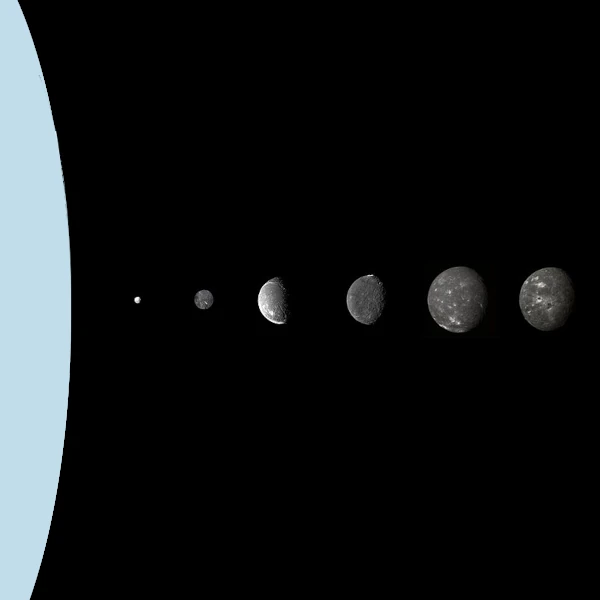
Uranus has 27 confirmed natural satellites, all named after characters from the works of William Shakespeare (1564-1616) and Alexander Pope (1688-1744). This system is distinguished by its extreme 98° tilt, suggesting a catastrophic tilt early in the planet's history. The major moons, discovered between 1787 and 1948, show geologically active surfaces despite their small size.
Their composition reveals a mixture of water ice and rocky materials, with possible traces of subsurface oceans for some. The Voyager 2 mission (1986) remains the only one to have flown by this system, providing 60% of our current knowledge.
Unlike other planetary systems where moons orbit in the equatorial plane, those of Uranus follow its axial tilt:
| Name | Diameter (km) | Semi-major axis (km) | Orbital period (days) | Group | Particularities |
|---|---|---|---|---|---|
| Titania | 1,578 | 435,910 | 8.71 | Major moons | Largest moon; 1,500 km canyons (Messina Chasma); possible subsurface ocean |
| Oberon | 1,523 | 583,520 | 13.46 | Major moons | Ancient surface with dark-floored craters; albedo of 0.24 |
| Ariel | 1,158 | 191,020 | 2.52 | Major moons | Youngest surface among major moons; traces of cryovolcanism |
| Umbriel | 1,170 | 266,000 | 4.14 | Major moons | Wunda crater (131 km) with bright ring; darkest surface |
| Miranda | 472 | 129,390 | 1.41 | Major moons | 20 km cliffs (Verona Rupes); chaotic surface suggesting a violent geological history |
| Puck | 162 | 86,000 | 0.76 | Inner moons | Discovered by Voyager 2 in 1985; spheroidal shape |
| Sycorax | 150 | 12,179,000 | 1,288.3 | Irregular moons | Retrograde orbit; reddish color (indication of organic materials) |
| Setebos | 48 | 17,418,000 | 2,225.2 | Irregular moons | Retrograde orbit; named after a god from The Tempest (Shakespeare) |
| Prospero | 50 | 16,256,000 | 1,978.3 | Irregular moons | Inclination of 152°; possible captured Kuiper Belt object |
| Stephano | 32 | 8,004,000 | 677.4 | Irregular moons | Prograde but highly eccentric orbit (e = 0.23) |
| Trinculo | 18 | 8,504,000 | 749.2 | Irregular moons | Discovered in 2001; chaotic orbit influenced by Sycorax |
| Francisco | 22 | 4,276,000 | 266.6 | Irregular moons | Retrograde orbit; unknown rotation period |
| Ferdinand | 20 | 20,901,000 | 2,887.2 | Irregular moons | Farthest moon; long-term unstable orbit |
| Caliban | 72 | 7,231,000 | 579.7 | Irregular moons | Red color (spectrum similar to trans-Neptunian objects) |
| Belinda | 90 | 75,255 | 0.62 | Inner moons | Gray surface; possible past collision with Cressida |
| Cressida | 82 | 61,770 | 0.46 | Inner moons | In 3:2 orbital resonance with Juliet; destined to collide with Desdemona |
| Juliet | 94 | 64,360 | 0.49 | Inner moons | Elongated shape; estimated density of 1.3 g/cm³ |
| Rosalind | 72 | 69,940 | 0.56 | Inner moons | Cratered surface; named after a character from As You Like It |
| Portia | 135 | 66,090 | 0.51 | Inner moons | Second largest inner moon; possible fragment of a parent body |
| Desdemona | 64 | 62,680 | 0.47 | Inner moons | Orbits between Cressida and Juliet; risk of collision in 4-100 million years |
| Bianca | 51 | 59,170 | 0.43 | Inner moons | High albedo (0.35); heavily cratered surface |
| Cordelia | 40 | 49,770 | 0.34 | Inner moons | Closest moon to Uranus; shepherd of the ε ring |
| Ophelia | 43 | 53,790 | 0.38 | Inner moons | Outer shepherd of the ε ring; 4:3 resonance with Cordelia |
| Perdita | 30 | 76,417 | 0.64 | Inner moons | Discovered in 1999 on Voyager 2 images; chaotic orbit |
| Mab | 25 | 97,736 | 0.92 | Inner moons | Probable source of the μ ring; very low density (< 1 g/cm³) |
| Cupid | 18 | 74,392 | 0.61 | Inner moons | Discovered in 2003; perturbed by Belinda |
| Margaret | 20 | 14,345,000 | 1,687.0 | Irregular moons | Only prograde irregular moon; very eccentric orbit (e = 0.66) |
Two hypotheses dominate to explain the origin of this atypical lunar system:
The low density of the major moons (< 1.7 g/cm³) indicates a high proportion of ice, consistent with formation in a volatile-rich disk. Their isotopic composition, measured by spectroscopy, shows similarities with Kuiper Belt comets.
No mission is currently planned for Uranus, but several projects are under study:
These missions could reveal whether moons like Ariel or Miranda harbor liquid oceans beneath their icy crusts, as suggested by the thermal model of Francis Nimmo (2020) based on VLA data.